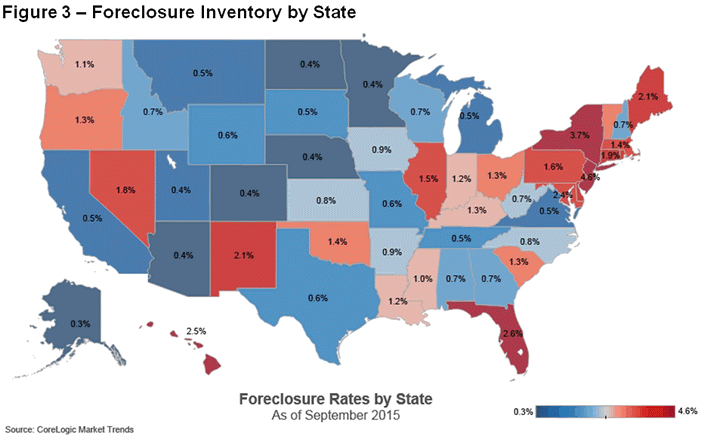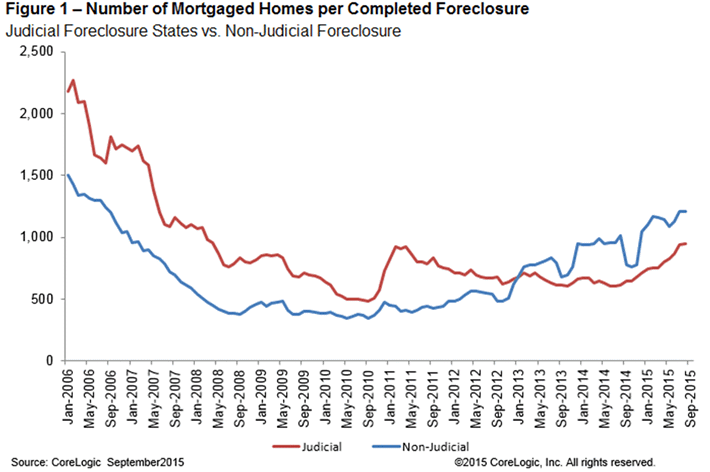The judicial foreclosure states appear to finally be clearing out their long-clogged foreclosure pipeline as foreclosure inventories declined notably on an annual basis in September. Completed foreclosures and serious delinquencies were also down on a year-over-year basis as reported in CoreLogic's September National Foreclosure Report.
The foreclosure inventory, homes in the foreclosure process, declined from 621,000 properties in September 2014 to 470,000, bringing the rate among homes with a mortgage down from 1.6 percent to 1.2 percent. That rate is driven by the judicial foreclosure states; 18 of the 21 such states have rates above the national average while among the states with a non-judicial process only three and the District of Columbia exceed the national average.
The five jurisdictions with the highest foreclosure inventory rate in September were New Jersey (4.6 percent), New York (3.7 percent), Florida (2.6 percent), Hawaii (2.5 percent) and the District of Columbia (2.4 percent). There were, however substantial reductions in the rate among the four judicial states; Florida's rates fell year-over-year by 1.8 percentage points, New Jersey by 1.0 point, New York was down 0.5 point, and Hawaii by 0.4 point. The District was essentially unchanged.

"The largest improvements in the foreclosure inventory continue to be in judicial states on the East Coast such as Florida and New Jersey," said Sam Khater, deputy chief economist for CoreLogic. "While the overwhelming majority of states are experiencing declines in their foreclosure rates, four states experienced small increases compared with a year ago."
Nationwide there was a drop of 17.6 percent in completed foreclosures compared with September 2014. The number decreased year over year from 67,000 to 55,000. This is an improvement in the number of completed foreclosures of 52.8 percent from the peak of 117,438 in September 2010. Figure 1 shows the increase in the number of homes per foreclosure, i.e. a decline in the rate.

There was a large increase in completed foreclosures compared to August. CoreLogic said the month-over-month basis surge of 49.5 percent from 37000 in August to 55,000 in September was an anomaly. Wayne County, Michigan, of which Detroit is the county seat, held a public action of thousands of tax foreclosed property during the month. As a basis of comparison, before the decline in the housing market in 2007, completed foreclosures averaged 21,000 per month nationwide between 2000 and 2006.
CoreLogic also reports that the number of mortgages in serious delinquency (defined as 90 days or more past due, including those loans in foreclosure or REO) declined by 21.2 percent from September 2014 to September 2015 with 1.3 million mortgages, or 3.4 percent, in this category. This is the lowest serious delinquency rate since December 2007.
"The rate of delinquencies continues to drop back closer to historic norms powered by improved economic conditions and tighter post-recession underwriting standards," said Anand Nallathambi, president and CEO of CoreLogic. "As we head into 2016, based on almost every major metric, the fundamentals underpinning the housing market are healthier than any time since 2007."
The five states with the highest number of completed foreclosures for the 12 months ending in September 2015 were: Florida (91,000), Michigan (45,000), Texas (32,000), Georgia (26,000) and California (26,000). These five states accounted for almost half of all completed foreclosures nationally.







